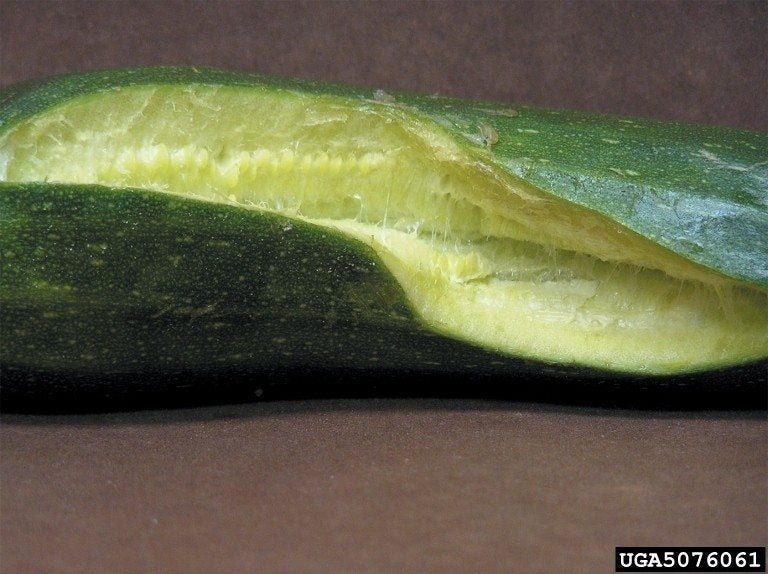Cucumbers Cracking Open: What To Do For Fruit Cracking In Cucumbers


Every gardener dreams of a beautiful vegetable plot filled with gorgeous, green plants heavy with fruits like cucumbers, tomatoes, and peppers. It's understandable then, why gardeners who find their cucumbers cracking open may be confused, wondering what has gone wrong. Let's learn more about what causes fruit cracking in cucumbers.
Why are My Cukes Cracked?
Cracking in cucumbers is an uncommon symptom that can occur in fruits that have been overwatered. Other common causes of cucumber fruit split are common plant pathogens -- angular leaf spot and belly rot can both cause fruit cracking in cucumbers when conditions are right.
Abiotic Problem: Irregular Irrigation
Cucumbers that receive irregular watering or that have been exposed to erratic weather patterns where lots of rain fell all at once may develop long, deep cracks. When cucumber plants are kept very dry during fruit initiation, the fruit skin loses some elasticity. As fruits expand, especially when water is suddenly applied in great amounts, the expanding fruits develop tears in surface tissues that expand into cracks similar to tomato cracking. The best control for abiotic fruit cracking is to provide regular, even watering. This can be difficult when rains are sporatic during the cucumber's fruiting, but if you wait to water just until the top 1 to 2 inches (2.5 to 5 cm.) of soil are dry, overwatering is less likely to occur. Applying a 4-inch (10 cm.) layer of organic mulch to plants can also help to keep soil moisture more even.
Bacterial Disease: Angular Leaf Spot
Angular leaf spot is considered primarily a disease of leaves, causing yellow-bordered spots that begin as small, water-soaked areas, but soon expand to fill the area between veins. Affected tissue browns before drying completely and falling out, leaving ragged holes in leaves. Bacteria may ooze from infected leaves onto fruit, where water-soaked spots up to 1/8-inch wide form. These superficial spots may turn white or tan before the skin of the cucumber fruit cracks. Pseudomonas syringae, the bacteria responsible for this disease, thrives in warm, humid conditions and may survive in the soil for two to three years. Crop rotation on a three-year cycle is generally sufficient to prevent re-occurrence, but if you save seed, they may require hot water sterilization before planting. Resistant cucumber varieties are available, including the picklers 'Calypso,' 'Lucky Strike', and 'Eureka' as well as slicers 'Daytona,' 'Fanfare', and 'Speedway.'
Fungal Disease: Belly Rot
Cucumbers that come in direct contact with the soil sometimes suffer from belly rot, an infestation of the fruit by the soil-borne fungus Rhizoctonia solani. Depending on the conditions and aggressiveness of the fungus, fruits may have yellow-brown discoloration on their undersides; brown, water-soaked areas of decay; or scabby cracked areas resulting from water-soaked decay that was stopped short by a sudden drying of the fruit's surface. Humid weather encourages belly rot infections, but symptoms may not develop until after harvest. Discourage colonization of cucumbers by growing your plants with a plastic barrier between the fruits and the ground -- plastic mulch serves this purpose beautifully. Chlorothalonil can be applied to cucumbers at risk when the first true pair of leaves emerge and again 14 days later.
Sign up for the Gardening Know How newsletter today and receive a free copy of our e-book "How to Grow Delicious Tomatoes".

Kristi Waterworth was a regular contributor to Gardening Know How for many years, answering countless queries on plant pests and diseases.